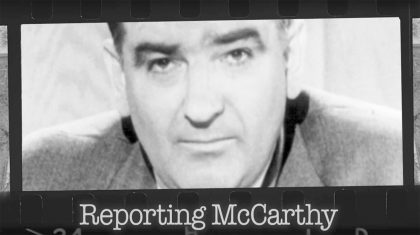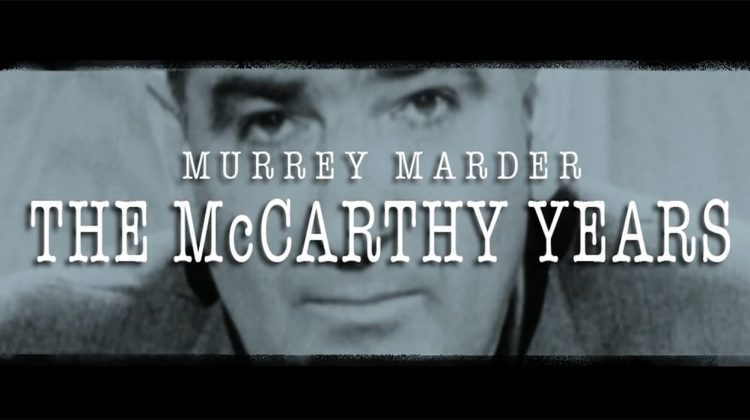The term “McCarthyism” originated when Sen. Joseph McCarthy made a speech in 1950 claiming that hundreds of communists were working in the government. What followed was years of investigations and hearings in which he drove people out of their jobs in the State Department and Central Intelligence Agency as well as universities and other careers, often with no evidence of any communist affiliations.
McCarthy’s major opposition came from journalists. Reporter Murrey Marder of The Washington Post was one of many who wrote against McCarthy. After news coverage by reporters like Marder, McCarthy was censured from the Senate after enough members voted to formally disavow and condemn him.
Videos
Murrey Marder remembers his reporting for The Washington Post that helped to unmask Sen. Joseph McCarthy.
Tags
Share
The following URL links directly to the video or page.
Copy and paste the code into your website to embed this video.
The late Murray Marder was a reporter for The Washington Post, who covered Sen. Joseph McCarthy, R-Wis., for more than five years. He talks about what it was like covering McCarthy day in and day out.
Share
The following URL links directly to the video or page.
Copy and paste the code into your website to embed this video.
Historical Timeline
Click on individual events to expand items one by one, or click the expand all button to view the entire contents of the timeline.
1947
- McCarthy Takes Office
-
January 3, 1947
Joseph McCarthy takes office as a Republican senator from Wisconsin.1 In a primary election, McCarthy had defeated Sen. Robert La Follette Jr., son of one of the icons of American liberalism. Branding himself as “Tail Gunner Joe,” McCarthy had run a vicious, negative campaign against his opponent with accusations that La Follette was a war profiteer.2
- Blacklist Established
-
November 24, 1947
The heads of several major Hollywood movie studios gather at the Waldorf Astoria Hotel in New York to respond to recent hearings of the House Un-American Activities Committee, or HUAC. Several prominent writers, actors and directors – a group that would later become known as the Hollywood Ten – refused to testify at the hearings about their alleged ties to the Communist Party. At the Waldorf, the studio heads decide they will refuse to hire anyone with Communist connections or anyone who won’t testify before HUAC. This is the first official formulation of a blacklist.3
1948
- Chambers Accuses Hiss
-
August 3, 1948
- At a HUAC hearing, former Communist Party member Whittaker Chambers accuses Alger Hiss, a former high-level State Department official, of being a Communist. Over the next several months, the committee hears dramatic allegations about Hiss’ double life as a Communist sympathizer working within the U.S. government.4
1950
- Hiss Convicted
-
January 21, 1950
A jury convicts Hiss of two counts of perjury for lying about his Communist connections.5 Many consider this to be the official end of the New Deal era. “For eighteen years [this country] had been run by New Dealers, Fair Dealers, Misdealers and Hiss dealers,” HUAC member Karl Mundt (R-S.D.) says.6
- McCarthy’s List
-
February 9, 1950
During a speech in Wheeling, W.Va., little-known Sen. McCarthy claims he has a list of 205 active Communist Party members and Soviet spies working in the State Department.7
- Senate Speech
-
February 20, 1950
In a follow-up to his Wheeling speech, McCarthy speaks to the Senate for five hours, claiming he has a list of 81 people who pose a risk to the State Department.
- Tydings Committee
-
March 8, 1950
McCarthy begins testifying before the Senate Subcommittee on the Investigation of Loyalty of State Department Employees — also known as the Tydings Committee — established in response to the senator’s allegations and named for its chairman, Sen. Millard Tydings (D-Md.). Although McCarthy reveals the names of nine supposed Communists in the State Department, the committee does not find any truth to the allegation of Communist penetration of the agency. Thanks to increasing press coverage, however, McCarthy’s fanatic behavior rapidly gains popularity.
- Rosenbergs Indicted
-
August 17, 1950
A federal grand jury indicts Julius Rosenberg and his wife, Ethel, on charges of espionage for leaking information about nuclear weapons technology to the Soviets.8
- McCarthy Assaults Journalist
-
December 12, 1950
Taking his combative nature with the press to the next level, McCarthy assaults muckraker Drew Pearson in the men’s cloakroom of the Sulgrave Club in Washington. Though Pearson sued McCarthy, the senator was never punished for his actions.9
1951
- Rosenbergs Convicted
-
March 29, 1951
The Rosenbergs are convicted of espionage.10 Two years later, they would be executed, the first civilians to be sentenced to death for espionage in American history.11 12 Many historians have concluded that Julius Rosenberg was, in fact, a Soviet spy but that Ethel, while she knew of her husband’s activities, did not actively participate in them.13
1952
- McCarthy Reelected
-
November 4, 1952
Press coverage, focusing mostly on McCarthy’s diatribes against his political opponents, helps McCarthy win re-election.14 He defeats Len Schmitt in the Republican primary and Democratic challenger Thomas Fairchild in the general election.
1953
- La Follette Suicide
-
February 24, 1953
Robert La Follette Jr., McCarthy’s opponent in the 1946 campaign, is found dead of a self-inflicted gunshot wound. La Follette had told friends that he feared he might have to testify before McCarthy about Communist infiltration of the committee he chaired while he was in Congress.15
- McCarthy Investigates Army
-
August 31, 1953
As chairman of the Senate Committee on Government Operations, McCarthy begins investigating alleged subversive infiltration of the Army Signal Corps at Fort Monmouth, N.J.16
- Radulovich Story
-
October 20, 1953
CBS broadcast journalist Edward R. Murrow, host of the popular show “See It Now,” airs the story of the wrongful discharge of Air Force Lt. Milo Radulovich, who becomes an example of the negative consequences of McCarthy’s anti-Communist hysteria. Within a month of Murrow’s report, the Air Force reinstates Radulovich.17
- Marder Reports
-
November 9, 1953
The Washington Post begins running a dramatic series of stories on McCarthy’s reckless charges against the Fort Monmouth Signal Corps written by reporter Murrey Marder. “Nothing that can be independently ascertained from information available here or in Washington indicates that there is any known evidence to support such a conclusion,” Marder writes.18
1954
- Murrow Reports
-
March 9, 1954
On “See It Now,” Murrow reveals weaknesses in McCarthy’s bombastic rhetoric by splicing together contradictory statements from the senator’s own speeches.19 One example of McCarthy’s inflammatory nature was his insistence that the Fifth Amendment was a “shield for the guilty.”20
- ‘At Long Last’
-
June 9, 1954
Toward the end of a long day of hearings, McCarthy engages in a confrontation with Army counselor Joseph Welch. McCarthy accuses a young lawyer at Welch’s firm of having worked for a Communist organization, despite a secret promise made days earlier by McCarthy’s lawyer, Roy Cohn, that the senator would not bring this up during the nationally televised hearings. Welch lambastes McCarthy, asking him, “Have you no sense of decency sir, at long last? Have you left no sense of decency?”22
- McCarthy Condemned
-
December 2, 1954
The Senate votes 67 to 22 in favor of condemning — but not censuring — McCarthy for false accusations and his crass demeanor throughout the Army-McCarthy hearings. Vice President Richard Nixon, presiding over the Senate, strikes the word “censure” from the resolution’s title at the last minute at the behest of McCarthy’s die-hard supporters who, as author Haynes Johnson put it, “launched an effort to discredit the proceedings and diminish the meaning of what took place.”23 Not a single act of espionage or subversion was ever found by McCarthy’s subcommittee.24
1957
- McCarthy Dies
-
May 2, 1957
Disgraced and downtrodden, McCarthy falls from the public eye and dies of alcoholism-related cirrhosis at the age of 48.
2005
- ‘Good Night’
-
October 14, 2005
“Good Night, and Good Luck” is released in theaters. Starring Jeff Daniels, Robert Downey Jr. and David Strathairn and directed by George Clooney, the film depicts what went on behind the scenes of Murrow’s “See It Now” broadcasts. It is nominated for six Academy Awards.25
Recommended References
BOOKS
- Adams, John G. Without Precedent: The Story of the Death of McCarthyism. New York: Norton, 1983.
- Alwood, Edward. Dark Days in the Newsroom: McCarthyism Aimed at the Press. Philadelphia: Temple University Press, 2007.
- Bayley, Edwin R. Joe McCarthy and the Press. Madison: The University of Wisconsin Press, 1981.
- Chambers, Whittaker. Witness. New York: Random House, 1952.
- Cohn, Roy. McCarthy. New York: Lancer Books, 1968.
- Fried, Richard M. Nightmare in Red: The McCarthy Era in Perspective. New York: Oxford University Press, 1990.
- Herman, Arthur. Joseph McCarthy: Reexamining the Life and Legacy of America’s Most Hated Senator. New York: Free Press, 2000.
- Johnson, Haynes. The Age of Anxiety: McCarthyism to Terrorism. Boston: Harcourt, 2005.
- Morgan, Ted. Reds: McCarthyism in Twentieth-Century America. New York: Random House, 2003.
- Oshinsky, David M. A Conspiracy So Immense: The World of Joe McCarthy. New York: Free Press, 1985.
- Reeves, Thomas C. The Life and Times of Joe McCarthy: A Biography, New York: Stein and Day, 1982.
- Rovere, Richard H. Senator Joe McCarthy. New York: Meridian, 1959.
- Sherrow, Victoria. Joseph McCarthy and the Cold War. Woodbridge, CT: Blackbirch Press, 1999.
- Zeinert, Karen. McCarthy and the Fear of Communism. Berkeley Heights, NJ: Enslow Publishers, 1998.
AUDIO/VISUAL
- Transcript of Edward R. Murrow’s “A Report on Senator Joseph R. McCarthy”
- Transcript of McCarthy’s 1950 Lincoln Day Speech
- Senate explanation for McCarthy’s Lincoln Day speech
- On “See It Now”
ENDNOTES
- 1Joseph McCarthy's Senate biography
- 2Johnson, Haynes. The Age of Anxiety: McCarthyism to Terrorism. Orlando, FL: Harcourt, 2005: 56-67.
- 3Fried, Richard M. Nightmare in Red: The McCarthy Era in Perspective. New York: Oxford University Press, 1990: 77-78.
- 4Fried, 19-20.
- 5Fried, 17.
- 6Fried, 22.
- 7Reeves, Thomas C. The Life and Times of Joe McCarthy: A Biography. New York: Stein and Day, 1982: 224.
- 8“The Atom Spy Case.” FBI – Famous Cases and Criminals. FBI, n.d. Web. 8 Feb. 2012.
- 9Bayley, Edwin R. Joe McCarthy and the Press. Madison: University of Wisconsin Press, 1981: 166.
- 10“The Atom Spy Case.”
- 11“50 years later, Rosenberg execution is still fresh.” Associated Press 7 June 2003: n.pag. USAToday.com. Web. 8 Feb. 2012.
- 12“The Atom Spy Case.”
- 13Roberts, Sam. “Figure in Rosenberg Case Admits to Soviet Spying.” New York Times 11 Sept. 2008, New York ed.: A1. NYTimes.com. Web. 8 Feb. 2012.
- 14Bayley, 104.
- 15Johnson, 263.
- 16Reeves, 517.
- 17Martin, Douglas. “Milo Radulovich, 81, Dies; Symbol of ’50s Red Scare.” New York Times 21 Nov. 2007. NYTimes.com. Web. 8 Feb. 2012.
- 18Oshinsky, David M. A Conspiracy So Immense: The World of Joe McCarthy. New York: The Free Press/MacMillan, 1983: 338.
- 19Reeves, 564.
- 20Reeves, 522.
- 21Doherty, Thomas. “The Army-McCarthy Hearings.” The Museum of Broadcast Communications. Web. 8 Feb. 2012.
- 22Johnson, 413-424.
- 23Johnson, 441.
- 24Reeves, 526.
- 25“Good Night, and Good Luck.” Internet Movie Database (IMDb). Web. 8 Feb. 2012.

 Reporting McCarthy
Reporting McCarthy  Reporting McCarthy
Reporting McCarthy  The McCarthy Years
The McCarthy Years  The McCarthy Years
The McCarthy Years